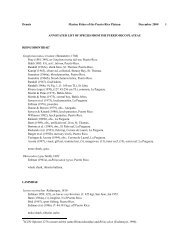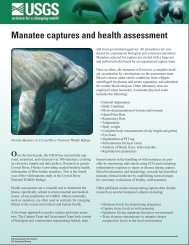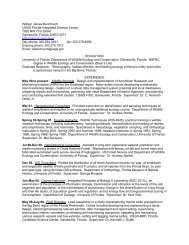Channa striata (Bloch, 1793) Chevron Snakehead
Channa striata (Bloch, 1793) Chevron Snakehead
Channa striata (Bloch, 1793) Chevron Snakehead
You also want an ePaper? Increase the reach of your titles
YUMPU automatically turns print PDFs into web optimized ePapers that Google loves.
Temperature regimes at that locality would preclude<br />
presence of northern snakehead, but is likely indicative<br />
that the chevron snakehead is the species involved,<br />
probably introduced from populations established in<br />
Papua, Indonesia. If so, this would be the first record of<br />
a snakehead from Papua New Guinea.<br />
Size: To 90 cm (Bardach and others, 1972);<br />
91.4 cm (Sen, 1985). Can attain a length of 30-36 cm<br />
in 1 year (Bhatt, 1970). Talwar and Jhingran (1992)<br />
stated that this species is sexually mature at 30 cm, but<br />
added that 2 years were required to reach that size.<br />
Murugesan (1978), however, recorded a growth rate<br />
of 1.3 to 3.0 mm/day for the first 3 months, slowing to<br />
0.3 to 0.9 mm/day thereafter. He also reported lengths<br />
of 25-27 cm in 13½ months and 23.4-31.7 cm in 9½<br />
months in Kerala State, India; 32 cm in 2 years in West<br />
Bengal; and 30.5l cm in 2 years in Madras. In rivers of<br />
Uttar Pradesh, chevron snakeheads grew to 32 cm in<br />
2 years.<br />
Habitat preference: Freshwater ponds and<br />
streams, usually in stagnant muddy waters; primarily<br />
found on plains in India (Talwar and Jhingran, 1992).<br />
It occurs in reservoirs in Sri Lanka (Fernando and<br />
Indrassna, 1969). Nevertheless, in Malaysia this<br />
species is reported to exist in rivers, lakes, swamps,<br />
rice paddies, mining pools, and roadside ditches<br />
(Mohsin and Ambak, 1983; Lee and Ng, 1991). Ng<br />
and Lim (1990) listed this species from “open country<br />
areas,” adding that it is the primary snakehead in shallow<br />
waters (1 m or less) with dense vegetation. In<br />
India, it can be found in reservoirs and rice paddies<br />
(Jhingran, 1984). In Keoladeo National Park, Bharatpur,<br />
Rajasthan, north-central India, it may be found in<br />
open water to dense mats of aquatic vegetation (Kumar<br />
and Mittal, 1993). Herre (1924), Umali (1950), and<br />
Conlu, 1986) recorded it from lakes and lowland rivers<br />
in the Philippines, and its introduction to two crater<br />
lakes at an altitude about 1,050 m above sea level.<br />
Kottelat (1998) reported a preference for “standing<br />
waters.” Lee and Ng (1991) noted that this species<br />
seems to be the most adaptable snakehead, tolerating<br />
“quite foul water” and able to move overland.<br />
<strong>Channa</strong> <strong>striata</strong> is an obligate airbreather. Vivekanandan<br />
(1977a,b) stated that the breathing organ is<br />
developed in about 60 days during growth from a length<br />
of 1 to 4.5 cm at 26-28 ºC. Singh and others (1986)<br />
noted that at 28 ºC, this species breathes aquatically until<br />
18 to 20 days following hatching when young reach a<br />
length of 1.1-1.2 cm and, thereafter, becomes a bimodal<br />
breather. They measured a decrease in oxygen uptake<br />
through the gills and skin of almost 42 percent once<br />
bimodal respiration began. Pandian (1982) reported that<br />
fingerlings of this species spend up to 15 percent of the<br />
time in surfacing and related activities.<br />
Varma (1979) recorded a pH range for <strong>Channa</strong><br />
<strong>striata</strong> of 4.25 to 9.40 with 100 percent survival over<br />
72 hours, and 90 percent survival at pH 3.10 for the<br />
same period.<br />
Temperature range: No specific information,<br />
but native range lies between about 32º N and 7º N,<br />
indicative of a fish that is temperate to tropical.<br />
Reproductive habits: Lee and Ng (1991)<br />
indicated the species as solitary except during spawning<br />
seasons. In India, pairs breed during most months of the<br />
year, laying a few hundred to more than 1,000 ambercolored<br />
eggs (Parameswaran and Murugesan, 1976a;<br />
Talwar and Jhingran, 1992). Peak spawning coincides<br />
with peak rainfall (Parameswaran and Murugesan,<br />
1976a). Howell (1913) said the eggs average about<br />
1.25 mm and are nonadhesive, hatching in 1 to 3 days.<br />
Females mature about 30 cm in length at about 2 years<br />
of age (Talwar and Jhingran, 1992; Ali, 1999). Parents<br />
clear a shallow depression by biting off aquatic vegetation<br />
(Ling, 1977). Nevertheless, Alikunhi (1953)<br />
remarked that <strong>Channa</strong> <strong>striata</strong> will spawn in the absence<br />
of vegetation. Eggs float to the surface after fertilization<br />
(Lee and Ng, 1991). The pelagic eggs are guarded by<br />
both parents in the Philippines (Lowe-McConnell,<br />
1987) and possibly throughout the native range of the<br />
species. Nevertheless, Herre (1924) stated that one or<br />
the other parent guards the nest at all times, and that if<br />
food becomes scarce, parents become cannibalistic on<br />
the young. He further indicated that in the Philippines,<br />
C. <strong>striata</strong> spawns throughout the year and that many,<br />
perhaps all, breed twice annually. Ali (1999) confirmed<br />
ripe females present throughout the year in ricefields in<br />
Perak, northwestern Malaysia. Peak spawning in southwestern<br />
Sri Lanka occurs between May and September,<br />
with a secondary spawning October through December<br />
(Kilambi, 1986). Jhingran (1984) cited fecundity as<br />
3,000-30,000 ova. Lee and Ng (1991) stated that they<br />
had collected fry without seeing parents nearby. They<br />
also said that eggs hatch in 3 days in Malaysia, the fry<br />
developing a deep orange color. This pattern persists<br />
until the young reach a length of 15 mm when only an<br />
orange lateral stripe remains. At 40 mm in length, all<br />
orange color is lost but a “pseudo-ocellus” appears on<br />
the posterior lobe of the dorsal fin, a characteristic lost<br />
in adulthood. Mookerjee and others (1948) described<br />
and illustrated early development of C. <strong>striata</strong>.<br />
117







